| L(s) = 1 | + (1.29 − 2.24i)2-s + (−2.34 − 4.06i)4-s − 2.28·5-s + (−2.08 − 1.63i)7-s − 6.97·8-s + (−2.95 + 5.11i)10-s + 2.95·11-s + (−2.13 + 3.69i)13-s + (−6.34 + 2.56i)14-s + (−4.32 + 7.49i)16-s + (−0.764 + 1.32i)17-s + (−3.69 − 6.39i)19-s + (5.35 + 9.28i)20-s + (3.82 − 6.62i)22-s + 6.15·23-s + ⋯ |
| L(s) = 1 | + (0.914 − 1.58i)2-s + (−1.17 − 2.03i)4-s − 1.02·5-s + (−0.787 − 0.616i)7-s − 2.46·8-s + (−0.934 + 1.61i)10-s + 0.891·11-s + (−0.591 + 1.02i)13-s + (−1.69 + 0.684i)14-s + (−1.08 + 1.87i)16-s + (−0.185 + 0.321i)17-s + (−0.846 − 1.46i)19-s + (1.19 + 2.07i)20-s + (0.815 − 1.41i)22-s + 1.28·23-s + ⋯ |
Λ(s)=(=(567s/2ΓC(s)L(s)(−0.474−0.880i)Λ(2−s)
Λ(s)=(=(567s/2ΓC(s+1/2)L(s)(−0.474−0.880i)Λ(1−s)
| Degree: |
2 |
| Conductor: |
567
= 34⋅7
|
| Sign: |
−0.474−0.880i
|
| Analytic conductor: |
4.52751 |
| Root analytic conductor: |
2.12779 |
| Motivic weight: |
1 |
| Rational: |
no |
| Arithmetic: |
yes |
| Character: |
χ567(109,⋅)
|
| Primitive: |
yes
|
| Self-dual: |
no
|
| Analytic rank: |
0
|
| Selberg data: |
(2, 567, ( :1/2), −0.474−0.880i)
|
Particular Values
| L(1) |
≈ |
0.535648+0.897340i |
| L(21) |
≈ |
0.535648+0.897340i |
| L(23) |
|
not available |
| L(1) |
|
not available |
L(s)=p∏Fp(p−s)−1 | p | Fp(T) |
|---|
| bad | 3 | 1 |
| 7 | 1+(2.08+1.63i)T |
| good | 2 | 1+(−1.29+2.24i)T+(−1−1.73i)T2 |
| 5 | 1+2.28T+5T2 |
| 11 | 1−2.95T+11T2 |
| 13 | 1+(2.13−3.69i)T+(−6.5−11.2i)T2 |
| 17 | 1+(0.764−1.32i)T+(−8.5−14.7i)T2 |
| 19 | 1+(3.69+6.39i)T+(−9.5+16.4i)T2 |
| 23 | 1−6.15T+23T2 |
| 29 | 1+(1.17+2.02i)T+(−14.5+25.1i)T2 |
| 31 | 1+(3.11+5.38i)T+(−15.5+26.8i)T2 |
| 37 | 1+(3.58+6.21i)T+(−18.5+32.0i)T2 |
| 41 | 1+(3.94−6.83i)T+(−20.5−35.5i)T2 |
| 43 | 1+(0.417+0.722i)T+(−21.5+37.2i)T2 |
| 47 | 1+(−2.91+5.04i)T+(−23.5−40.7i)T2 |
| 53 | 1+(−3.71+6.44i)T+(−26.5−45.8i)T2 |
| 59 | 1+(2.31+4.00i)T+(−29.5+51.0i)T2 |
| 61 | 1+(−3.56+6.17i)T+(−30.5−52.8i)T2 |
| 67 | 1+(−1.66−2.87i)T+(−33.5+58.0i)T2 |
| 71 | 1+0.160T+71T2 |
| 73 | 1+(−0.190+0.329i)T+(−36.5−63.2i)T2 |
| 79 | 1+(−3.97+6.88i)T+(−39.5−68.4i)T2 |
| 83 | 1+(−2.14−3.72i)T+(−41.5+71.8i)T2 |
| 89 | 1+(3.02+5.24i)T+(−44.5+77.0i)T2 |
| 97 | 1+(−0.661−1.14i)T+(−48.5+84.0i)T2 |
| show more | |
| show less | |
L(s)=p∏ j=1∏2(1−αj,pp−s)−1
Imaginary part of the first few zeros on the critical line
−10.49058872240353760305658951696, −9.485870412010980895302343287764, −8.905238614689408033666105350117, −7.22957716594408565108386377579, −6.42377487089434661090435755488, −4.86843804450759544720056239592, −4.10107073509334457562733514498, −3.48444940943811202632110840672, −2.16232306959341417980756373950, −0.43598902480773177547188798239,
3.17448927382438564620306559757, 3.89824043188633756207852877932, 5.02877255570607615551498141621, 5.90117261763225180139346086875, 6.82156369083884168371378790030, 7.48690663581172456090797017230, 8.444873437880269726162909753881, 9.064408036808993966817980561781, 10.41195479304186732316196214635, 11.84877300164264630758833268202

